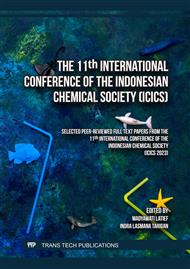[1]
S. Munasari, D. Sandri, and J. Jefriadi, "Daya Terima Panelis dan Karakterisasi Selai Kulit Pisang Kepok dengan Penambahan Pisang Ambon," JTAI, vol. 5, no. 1, p.10–17, Jul. 2018.
DOI: 10.34128/jtai.v5i1.61
Google Scholar
[2]
R.N.S. Gurning, S. H. Puarada, and M. Fuadi, "Pemanfaatan Limbah Buah Pisang Menjadi Selai Kulit Pisang sebagai Peningkatan Nilai Guna Pisang," E-DIMAS, vol. 12, no. 1, p.106–111, 2021.
DOI: 10.26877/e-dimas.v12i1.6395
Google Scholar
[3]
M. Megawati and E. L. Machsunah, "Ekstraksi pektin dari Kulit Pisang Kepok (Musa paradisiaca) Menggunakan Pelarut HCl Sebagai Edible Film," JBAT, vol. 5, no. 1, p.14–21, Jun. 2016.
DOI: 10.15294/jbat.v5i1.4177
Google Scholar
[4]
N.L.E.H. Santhi, I.K.S. Jaya, R. Sofiyatin, and A.C. Dewi, "Kajian Sifat Organoleptik dan Kadar Air Selai Daging Kulit Pisang Kepok," Jurnal Gizi Prima, vol. 2, no. 1, p.38–46, 2017.
Google Scholar
[5]
F.I.G.D. Rocha Concenço, P.C. Stringheta, A.M. Ramos, and I.H. Terayama Oliveira, "Blueberry: Functional Traits and Obtention of Bioactive Compounds," AJPS, vol. 05, no. 18, p.2633–2645, 2014.
DOI: 10.4236/ajps.2014.518278
Google Scholar
[6]
A. Herianto, F. Hamzah, and Yusmarini, "Study of the Use Banana Mas (Musa Acuminata) and Red Dragon Fruit (Hylocereus Polyrhizus) in the Preparation of Jam," JOM FAPERTA, vol. 2, no. 2, p.1–12, 2015.
Google Scholar
[7]
Y. Sutriono and U. Pato, "Utilization Belanda Eggplant and Kepok Banana Peel in Making Jam," vol. 3, no. 2, 2016.
Google Scholar
[8]
S. A. Nurfiliyah and S. B. Widjanarko, "Uji Efektifitas Pelepasan Retronasal Aroma Jeli Pisang Ambon Putih," Jurnal Pangan dan Agroindustri, vol. 2, no. 2, p.9–15, 2014.
Google Scholar
[9]
Y. H. Isnaini, J. Jariyah, and I. Defri, "Karakteristik Velva Pisang-Bluberi dengan Variasi Konsentrasi CMC," JFTA, vol. 4, no. 2, p.51–58, Aug. 2022.
DOI: 10.24929/jfta.v4i2.1910
Google Scholar
[10]
P. M. Reque et al., "Characterization of blueberry fruits (Vaccinium spp.) and derived products," Food Sci. Technol (Campinas), vol. 34, no. 4, p.773–779, Dec. 2014.
DOI: 10.1590/1678-457X.6470
Google Scholar
[11]
D. Stevenson and J. Scalzo, "Anthocyanin composition and content of blueberries from around the world," Journal of Berry Research, vol. 2, no. 4, p.179–189, 2012.
DOI: 10.3233/JBR-2012-038
Google Scholar
[12]
P. J. Palupi, R. Prasetia, Muh. D. Pratama, and I. Sriwahyuni, "Karakteristik Fisikokimia Selai Kulit Buah Naga (Hylocereus polyrhizus) dengan Penambahan Variasi Konsentrasi Buah Nanas (Ananas comosus L.)," J-AGT, vol. 15, no. 01, p.59, Jul. 2021.
DOI: 10.19184/j-agt.v15i01.20644
Google Scholar
[13]
C.F. Forney, S. Qiu, M.A. Jordan, D. McCarthy, and S. Fillmore, "Comparison of Volatile Compounds Contributing to Flavor of Wild Lowbush (Vaccinium augustifolium) and Cultivated Highbush (Vaccinium corymbosum) Blueberry Fruit Using Gas Chromatography-Olfactometry," Foods, vol. 11, no. 16, p.2516, Aug. 2022.
DOI: 10.3390/foods11162516
Google Scholar


